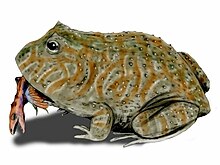Beelzebufo
| Beelzebufo | |
|---|---|

| |
| Life restoration of a B. ampinga eating a theropod | |
| Scientific classification | |
| Kingdom: | Animalia |
| Phylum: | Chordata |
| Class: | Amphibia |
| Order: | Anura |
| Family: | Ceratophryidae |
| Genus: | †Beelzebufo Evans, Jones, & Krause, 2008 |
| Type species | |
| †Beelzebufo ampinga Evans, Jones, & Krause, 2008
| |
| Species | |
|
†B. ampinga Evans, Jones, & Krause, 2008 | |
Beelzebufo ampinga (/biːˌɛlzɪˈbjuːfoʊ æmˈpɪŋɡə/ or /ˌbiːlzəˈbjuːfoʊ/) was a particularly large species of prehistoric frog described in 2008. Common names assigned by the popular media include devil frog,[1] devil toad,[2] and the frog from hell.[3]
Fossils of Beelzebufo have been recovered from strata of the Maevarano Formation in Madagascar, dating to the late Cretaceous period, some 70 million years ago (Mya).[4]
Etymology[]
The generic name Beelzebufo is a portmanteau of Beelzebub (a Semitic deity whose name may be translated as "Lord of the Flies", sometimes identified either as one of the chief lieutenants, or alter ego of the Christian Devil) and bufo (Latin for "toad").
The specific name ampinga means "shield" in Malagasy.
Description[]

In early studies, it is suggested that snout-vent lengths of up to 42.5 cm (16.7 in).[4] But in later studies, animals of this species estimated to have grown to at least 23.2 cm (9.1 in) (snout-vent length), which is around the size a modern African bullfrog can reach.[5] The head of Beelzebufo was very big,[5] and bones of the skull roof show a rugous external surface, indicating at least parts of the head may have borne bony scales, called scutes.
The skull sutures are open in even the largest specimens of Beelzebufo, showing that it might have grown even bigger.
Biogeography[]
The fossils of Beelzebufo appear in what is now Madagascar, which, still attached to India, had split from the coast of Somalia in the earliest stage of the late Jurassic.[6] It superficially resembles horned toads of South America, which had formerly led to consider a close biogeographic link between Madagascar and South America during the Cretaceous.[4][5]
However, Beelzebufo is not closely related to horned frogs and their similarities are considered to have evolved by convergence.[7][8] As occur with other extinct frogs formerly considered related to Ceratophryidae, such as Baurubatrachus, Beelzebufo might be instead part of a more ancient group of Neobatrachia, distantly related to horned frogs.[8]
Lifestyle[]

Beelzebufo most likely was a predator whose expansive mouth allowed it to eat relatively large prey, perhaps even juvenile dinosaurs.[9] Bite force measurements from a growth series of Cranwell's horned frog (Ceratophrys cranwelli), suggest that the bite force of a large Beelzebufo (skull width 15.4 cm) may have been between 500 and 2200 N. [10]
Discovery[]
This section does not cite any sources. (April 2018) |
The first fossil fragments were found in 1993 by David W. Krause of New York's Stony Brook University, but it took 14 years for scientists Susan E. Evans, Marc E. H. Jones, and Krause to assemble enough data for publication in the Proceedings of the National Academy of Sciences, the journal of the United States National Academy of Sciences.
Some 75 fossil fragments have been found. Researchers have been able to reconstruct parts of the frog's skeleton, including nearly the entire skull.
See also[]
References[]
- ^ Dybas, Cheryl (2008-02-18). "Scientists Discover 'Giant Fossil Frog from Hell'". Press Release 08-025. National Science Foundation. Archived from the original on 26 February 2008. Retrieved 2008-02-19.
- ^ "Scientists find 'Devil Toad' fossil". Associated Press. 2008-02-18. Retrieved 2008-02-19.
- ^ Hooper, Rowan (2008-02-18). "Giant prehistoric frog hints at ancient land link". New Scientist. Archived from the original on 26 February 2008. Retrieved 2008-02-19.
- ^ Jump up to: a b c Evans, Susan E.; Jones, Marc E. H.; David W. Krause (2008). "A giant frog with South American affinities from the Late Cretaceous of Madagascar". Proceedings of the National Academy of Sciences of the United States of America. 105 (8): 2951–2956. Bibcode:2008PNAS..105.2951E. doi:10.1073/pnas.0707599105. PMC 2268566. PMID 18287076.
- ^ Jump up to: a b c Evans S, Groenke J, Jones M, Turner A, Krause D (2014). "New Material of Beelzebufo, a Hyperossified Frog (Amphibia: Anura) from the Late Cretaceous of Madagascar". PLOS ONE. 9 (1): e87236. Bibcode:2014PLoSO...987236E. doi:10.1371/journal.pone.0087236. PMC 3905036. PMID 24489877.CS1 maint: multiple names: authors list (link)
- ^ Lawrence A. Lawver, Lisa M. Gahagan and Ian w.D. Dalziel, "A tight-fit early Mesozoic Gondwana: a plate reconstruction perspective", 1999, p. 5 "Africa-Madagascar", with citations (on-line text Archived 2008-10-12 at the Wayback Machine).
- ^ Ruane, S.; Pyron, R. A.; Burbrink, F. T. (2011). "Phylogenetic relationships of the Cretaceous frog Beelzebufo from Madagascar and the placement of fossil constraints based on temporal and phylogenetic evidence: Phylogenetic placement of Beelzebufo". Journal of Evolutionary Biology. 24 (2): 274–285. doi:10.1111/j.1420-9101.2010.02164.x. PMID 21044207. S2CID 45674192.
- ^ Jump up to: a b Báez, Ana María; Gómez, Raúl Orencio (2018). "Dealing with homoplasy: osteology and phylogenetic relationships of the bizarre neobatrachian frog Baurubatrachus pricei from the Upper Cretaceous of Brazil". Journal of Systematic Palaeontology. 16 (4): 279–308. doi:10.1080/14772019.2017.1287130. hdl:11336/21138. ISSN 1477-2019. S2CID 133862112.
- ^ "'Frog from hell' fossil unearthed". BBC News. 2008-02-18. Archived from the original on 21 February 2008. Retrieved 2008-02-18.
- ^ ; Wilcox, S.C.; Moriarty, D. J.; Stoeppler, Stephanie A. R.; Evans, Susan E.; Jones, Marc E. H. (2017). "Bite force in the horned frog (Ceratophrys cranwelli) with implications for extinct giant frogs". Scientific Reports. 7 (1): 11963. Bibcode:2017NatSR...711963L. doi:10.1038/s41598-017-11968-6. PMC 5607344. PMID 28931936.
External links[]
| Wikispecies has information related to Beelzebufo ampinga. |
| Wikimedia Commons has media related to Beelzebufo. |
- Cretaceous frogs
- Late Cretaceous amphibians
- Maevarano fauna
- Fossil taxa described in 2008
- Maastrichtian life
- Beelzebub